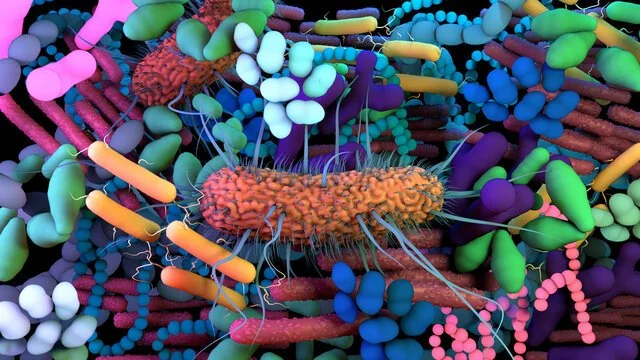Scent Science: How Microbes Might Influence Our Sense of Smell
By Jake Robinson
In the complex interplay between animals and microbes, an intriguing area of research has emerged – the relationship between the microbiome and the sense of smell. Recent evidence suggests that the microbial communities residing in our (and other animals’) bodies might play a significant role in shaping the olfactory system.
The Olfactory System
The olfactory system – the body's mechanism for detecting and interpreting smells – is an incredibly sophisticated and nuanced system. It is known to be influenced by a range of factors, from genetics to environmental exposures. The term ‘olfactory’ comes from the Latin word ‘olfactorius’, which in turn derives from the verb ‘olfacere’. Olfacere is a combination of ‘olere’, meaning ‘to smell’, and ‘facere’, meaning ‘to make’ or ‘to do’. So, ‘olfactory’ essentially relates to the act or process of smelling.
It begins in the nasal cavity, where the roof is lined with a specialised tissue known as the olfactory epithelium. This tissue contains olfactory receptor neurons, which are unique due to their ability to regenerate. Each of these neurons expresses one type of odorant receptor, and it's the combination of inputs from these neurons that allows us to recognise a vast array of different odours. When an odorant molecule binds to an odorant receptor on these neurons, it triggers an electrical signal that travels to the olfactory bulb, a structure at the base of the brain.
Within the olfactory bulb, the electrical signal is processed and relayed to several brain regions. This includes areas responsible for identifying odours and integrating them with other sensory information (the olfactory cortex), as well as areas involved in memory and emotion (the amygdala and the hippocampus). This complex network of interactions explains why certain smells can trigger powerful memories or emotional responses. The olfactory system is unique among our senses for its direct connection to these areas of the brain, bypassing the thalamus, which is typically a relay station for sensory information. This allows smells to be processed and recognised incredibly quickly.
Microbes and Olfaction
Recent studies suggest that the microbiome – the vast community of bacteria, viruses, and other microbes that inhabit our bodies – might influence our olfactory system in several ways. One animal study demonstrated that gut bacteria could override host sensory decisions by mimicking the functions of certain molecules. In this study, a commensal gut bacterium called Providencia produced a chemical called tyramine. This chemical acts on the host’s olfactory system – the part of the body responsible for processing smells – and regulates the host’s aversive response to certain odours. Scientists believe that this process drives mutually advantageous food decisions, whereby the host is essentially manipulated into selecting food that benefits both the host and the bacterium.
“Activation of different combinations of olfactory receptors by bacterial products such as β-phenylethylamine have been shown even to control the expression of emotions such as fear and aggression.” Furthermore, research in mice has demonstrated that alterations in the gut microbiome can lead to changes in the animals' sense of smell.
Imagine if this is the case in humans – our gut microbes hijacking our olfactory system to make us crave a particular food or drink. Perhaps that’s why I love coffee, red wine and chocolate so much.
On a related note, microbes are responsible for making many of the smells and flavours in our favourite foods and drinks.
Other studies show that bacteria can manipulate other host behaviour through olfactory pathways. For example, individuals can be attracted to chemicals emitted by the fungus Saccharomyces cerevisiae and the bacterium Lactobacillus plantarum but repelled by chemicals emitted by Acetobacter malorum. Microbes can also trigger olfactory responses in animals such as zebrafish and mice, thereby affecting sociability and breeding. It is thought that microbes influence the host’s olfactory signalling systems by producing metabolites that function as odorants as well as influencing GABA production (a potent neurotransmitter).
The precise mechanisms still need to be unravelled. Still, one thing is clear: the microbiome can influence host perception of stimuli via sensory routes (e.g., by playing with the host’s ‘smelling’ system) and behaviours or decision-making in animals.
The interaction may be bidirectional, with the olfactory system influencing the composition of the microbiome and vice versa. The potential implications of the interplay between the microbiome and the olfactory system are vast. For instance, it could help explain why individuals with certain gastrointestinal disorders, which are often associated with changes in the gut microbiome, frequently report altered senses of smell and taste.
Understanding this relationship could also pave the way for novel therapeutic approaches. For instance, could manipulating the microbiome help improve function in people with olfactory disorders? Could it influence dietary choices and eating behaviours, with implications for weight management and overall health? Also, might microbially-mediated changes in olfaction influence our relationships by altering how attractive we are perceived to be? I’ve written about this before in a paper on the Holobiont Blindspot – check it out here.
As we continue to uncover the myriad ways that our microbiome interacts with animal bodies, the influence of microbes on the olfactory system stands as a fascinating area of study. While much remains to be learned, the potential applications – from mental and physical health to food and fragrance – are tantalising.
For more on how microbes interact with the olfactory system, check out my book Invisible Friends: How Microbes Shape Our Lives and the World Around Us.




